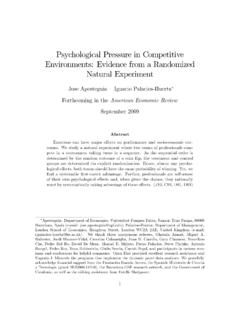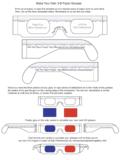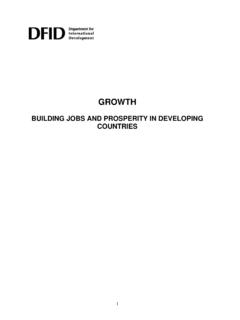Transcription of Professionals Play Minimax - Palacios Huerta
1 Review of Economic Studies (2003)70, 395 4150034-6527/03/00150395$ 2003 The Review of Economic Studies LimitedProfessionals play MinimaxIGNACIO Palacios -HUERTAB rown UniversityFirst version received September2001;final version accepted October2002(Eds.)The implications of the Minimax theorem are tested using natural data. The tests use a uniquedata set from penalty kicks in professional soccer games. In this natural setting experts play a one-shottwo-person zero-sum game. The results of the tests are remarkably consistent with equilibrium play inevery respect: (i) winning probabilities are statistically identical across strategies for players; (ii) players choices are serially independent. The tests have substantial power to distinguish equilibrium play fromdisequilibrium alternatives.
2 These results represent the first time that both implications of von Neumann sMinimax theorem are supported under natural INTRODUCTIOND uring the last few decades game theory has contributed to a reshaping of important aspectsof the methodology of Economics and other social sciences. In a large part this is because thelanguage, concepts and techniques of non-cooperative game theory have become central to manyareas of the discipline. Undoubtedly, studying the interaction of ideally rational players greatlyaids our understanding of the behaviour of real individuals, firms and other agents. Moreover, asKreps (1991) remarks, studying the former should aim at understanding the latter. The point ofgame theory is to help economists understand and predict what will happen in economic, socialand political contexts.
3 Theoretical contributions should thus feed back to empirical analysis. However, testing theimplications of the theory has proven extremely difficult in the literature. The primary reasonis that many predictions often hinge on properties of the utility functions and the values of therewards used. Even when predictions are invariant over classes of preferences, data on rewardsare seldom available in natural settings. Moreover, there is often great difficulty in determiningstrategy sets and in measuring individuals choices, effort levels, and the incentive structures theyface. As a result, even the most fundamental predictions of game-theoretical models have not yetbeen supported empirically in real view of the substantial problems associated with testing theoretical predictions usingnatural data, many authors have been compelled to test them in experimental enough, despite the controlled structure of experiments, the results of manyexperiments during the last few decades typically reject the assumption that subjects areplaying according to the theoretical implications ofequilibriumplay.
4 For instance, a numberof experiments have evaluated the empirical validity of von Neumann s Minimax Theory fortwo-person zero-sum games, a theory that occupies a central position in our understanding ofstrategic situations. The results have been mixed and are often rather negative (see, for instance,Brown and Rosenthal (1990), Rapoport and Boebel (1992), Camerer (2003), and the referencestherein).It is rightly argued, however, that in experimental settings individuals are often exposed togames and situations that they have not faced previously and that, despite their usual simplicity, itmay not be possible for them to become very proficient in the limited timeframe of an in turn has contributed to generating an important literature dealing with out-of-equilibrium395396 REVIEW OF ECONOMIC STUDIES play , or learning , in experimental , the state of affairs is such that eventhough the ability of game theoretical models to explain the diversity of individual behaviourin socioeconomic environments has significant theoretical and practical implications.
5 The majorequilibrium predictions of the theory have received little or no empirical paper offers an empirical examination of an aspect of the theory of strategicinteractions. A fundamental concept in many strategic situations is that one s actions mustnot be predictable by one s opponent. The theory of mixed strategy play , including vonNeumann s Minimax theorem and the general notion of a Nash equilibrium in mixed strategies,remains the essential basis of our theoretical understanding of strategic situations that this paper we use data from a natural strategic play in professional sports toprovide an empirical test of the Minimax theorem, an approach that has been recently followed byWalker and Wooders (2001).
6 Moreover, the specific features of the play and its environment allowthe analysis to overcome the usual difficulties that have plagued previous empirical attempts inthe literature, both in natural and experimental professional sports participants are experts at their games. This clearly presents a notableadvantage over many experiments, as the individuals are already the most proficient agents of thesituations of the game. However, despite the fact that situations that require unpredictable playand mutual outguessing are pervasive in sports, it is normally not feasible to conduct accurateempirical tests of the Minimax hypothesis in these scenarios. The reason is that players generallyhave many strategies available and outcomes are numerous.
7 In addition, outcomes are generallynot decided immediately after players choose their initial actions. There are subsequent strategicchoices that usually play a crucial role in determining final outcomes. As a result, it is essentiallyimpossible to obtain detailed data on all relevant variables to conduct informative of these usual difficulties and drawbacks are overcome in the natural setting we examinein this paper. We focus on a specific one-shot two-person zero-sum game in professional sportthat requires unpredictability and mutual outguessing. As in the typical experimental setting,the game has a precisely defined set of rules, few strategies are available, outcomes are decidedimmediately after strategies are chosen, and all relevant information is observable.
8 In contrastwith most experiments, however, professional players are highly motivated and experts at thegame. The analysis is concerned with a play of the world s most popular game: penalty kicks insoccer. To test the implications of the Minimax theorem, we exploit a unique data set of morethan 1400 penalty kicks in professional soccer games that includes very detailed information onall relevant aspects of the play , especially actions and a brief summary of the main results, we find that, as predicted by the theory ofmixed strategy play : (i) winning probabilities are statistically identical across strategies, and(ii) players choices are independent draws from a random process. The first result has beennotably difficult to obtain in the literature.
9 As to the second, essentially all previous tests ofrandomness in experimental research in psychology and economics have found that individuals switch strategies too often to be consistent with random play . When individuals are askedto generate or identify random sequences these sequences often have negative autocorrelations(see Bar-Hillel and Wagenaar (1991), Camerer (1995) for reviews of the literature). In our testsof the Minimax hypothesis, professional players are found to be capable of behaving perfectlyrandomly. Their sequences neither exhibit negative or positive autocorrelation, and choices donot depend on one s own previous play , on the opponent s previous plays or on past See Erev and Roth (1998), Camerer and Ho (1999), Stahl (2000), and many references Osborne and Rubinstein (1994) discuss a number of interpretations of mixed strategy play MINIMAX397We take these two results as consistent with the implications of the Minimax theorem.
10 Inthis sense, and to the best of our knowledge, they represent the first time that the fundamentalnotion of Nash equilibrium in mixed strategies is supported with real remainder of the paper is organized as follows. The following section describes thestructure and setting of the play , and the empirical hypothesis that will be evaluated. Section 3describes the data. Section 4 is devoted to the empirical analysis. Section 5 contains an evaluationof the power of the tests against non- Minimax behaviour, and a discussion of some extensions ofthe empirical analysis. Finally, Section 6 MIXED STRATEGIES IN PENALTY KICKSIn soccer, a penalty kick is awarded against a team which commits one of the ten punishableoffences inside its own penalty area while the ball is in play .







